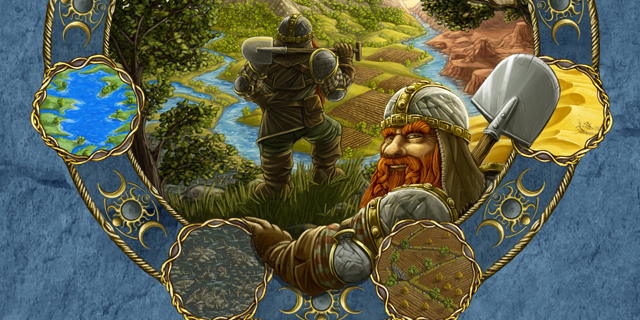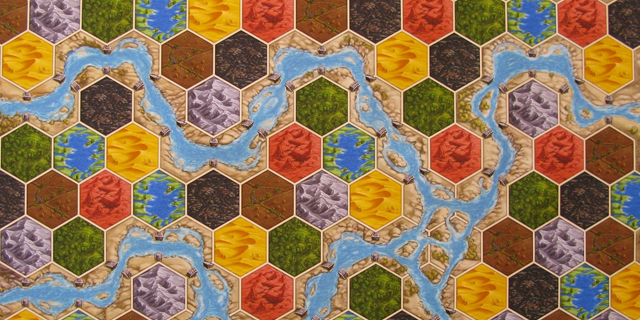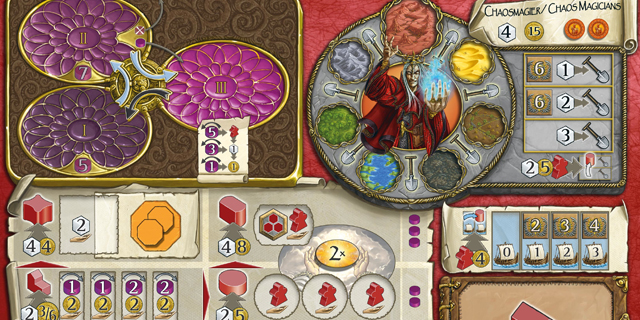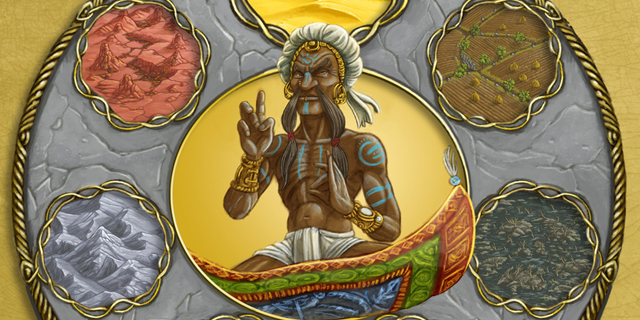
Territory control is a tried and true game mechanic. Usually these types of games feature a military conflict, each player wresting control from the others via show of force or trickery such as in Risk or Small World. But direct player conflict isn’t often a theme of European game design, opting instead for more passive tactics like obstruction. Terra Mystica (published by Z-Man in the US) not only eschews combat, but also puts the focus on the terrain itself.
The map of Terra Mystica is divided into hexes of seven different land types, plus rivers separating the various landmasses. The 14 available races that vie for control of it each call one of them home, with the two races sharing a given terrain type being mutually exclusive for any given game session. In order to expand their territory, a player must first terraform neighboring terrain into their preferred type.
But terraforming is just one of eight actions available at any given time. Others include upgrading an established building, improving your terraforming skill, developing your shipping network, executing a one-time power action from pool shared amongst all players, advancing your influence on one of the four elemental cult tracks, using a special action specific to your race or divine favors and even passing for the remainder of the round and selecting a bonus scroll. Most actions require the expenditure of workers, gold or priests. These resources are gained at the beginning of each round depending on which structures and other bonuses you have in play, although you can also spend power to generate them.

Power is an interesting mechanic that really makes Terra Mystica unique. Each race has three pools of power, and whenever a player gains power, they must advance power markers from their lowest occupied pool. Only power in the third pool can actually be used (which returns it to the first pool) for actions or resources, although players have the option of “burning” power from their second pool (losing it forever) to force the advancement of an equal amount. Power is gained in a few ways: as income at the start of each round, as rewards for crossing thresholds on the cult tracks, or from other players building structures next to yours — that last one is where the fun comes in.
In a game all about expanding territory, there are two mechanics that reward players for being close to each other. Gaining power is one, as each structure built next to yours provides you the option of gaining power at the cost of some of your victory points (one less point than the total power gained). Weighing the loss of VP versus the potential power gain is an agonizing choice that can easily come back to haunt you towards the end of the game. The other mechanic is the trading post, a structure that typically provides power and gold as income. Normally it costs a player a lot of gold (and some workers) to upgrade a dwelling to a trading post, but if that dwelling is adjacent to another player’s structure, the gold cost is halved. This is important not only for the trading post itself, but because trading posts can be upgraded to strongholds (which often unlock a race’s special power) or temples. Building a temple gains you a divine favor of your choice, provides priests as income, and allows you to later upgrade it to a powerful sanctuary.

All of this is nice and all, but how do you score points? Well, that depends. Each of the six rounds of play has one specific action that will score bonus points (randomly determined during setup), usually for constructing a specific type of building during that round. Some divine favors also grant you points for making structures should you select them. Many races have an inherent ability that gains them points for various action such as terraforming or building towns. Towns are groups of at least four adjacent hexes containing structures of a given power value, and are themselves worth points and other rewards. Passing for the round can earn you points depending on which bonus scroll you selected the last time you passed. Finally, at the end of the game points are awarded for the largest networks of structures (connected via shipping routes if necessary) and for ranking in each cult track. These last two awards are substantial and are usually the driving goals throughout play.
Six rounds of play might not seem like a lot, and it isn’t, but there are a ton of decisions that have to be made each time your turn comes up. The options can seem overwhelming at first, as you often will need to plan ahead for future turns, or even rounds, and carefully manage your resources to make sure those plans can happen. Then there are the other players. Is it worth expanding your territory next to them for access to cheaper trading posts and the possible power gain? By definition being adjacent to an opponent cuts off one of your avenues for expansion, and don’t forget they get the same benefits for being adjacent to you.
You also have to consider the potential for your opponents to cut you off, either from desired terrain or from crucial power actions that are first-come, first-served each round. Should you burn power in order to have enough to use one of them before someone else can? Can you afford to wait? Do you have to wait because if you don’t they’re clearly going to terraform the space you were eying, which will throw all your plans off.

And you will definitely need a plan if you want to succeed. Complicating this is the fact that all 14 races play differently, and you will need to adapt to your race’s strengths and weaknesses if you are to succeed. What worked for you last time might not work this time, and you don’t really have a lot of time to figure out what will work. Fortunately an amazingly comprehensive yet streamlined rulebook covers most interactions between races’ abilities and the core rules.
If Terra Mystica has a failing, it is the fact that it is incredibly prone to analysis paralysis for all of these reasons and more. The expected play time for a session is half an hour per player (up to five), and for the most part my experiences has supported this but I can easily see it being dragged out due to one or more becoming overwhelmed. This is not a gateway game by any means. At its core, Terra Mystica uses familiar mechanics in a somewhat unfamiliar way and any veteran board game player should be able to grasp it but they definitely need that background experience.
If you have such a group, Terra Mystica retails for around $80 due to the crazy amount of wood and cardboard pieces involved. The amount of replay value offered for that $80 is high, as mixing and matching 14 races should provide unique experiences for quite some time.



















